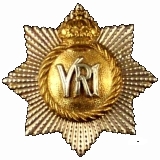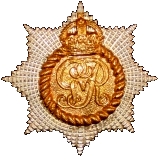
The Royal Canadian Regiment and
The First World War - 1914-1919
Surrendered as Stowaway
By: Captain Michael M. O'Leary, orginally published in the regimental journal of The Royal Canadian Regiment, PRO PATRIA 2010
In August 1915, The Royal Canadian Regiment returned to Halifax after a year as the garrison battalion in Bermuda. The Regiment arrived aboard the S.S. Caledonian, which had delivered the relieving unit, the 38th Canadian Infantry Battalion, to the island. Disembarking on 17 August, the Regiment was required to re-attest all officers and soldiers of the unit for overseas service in Europe because there was some concern whether they were legally able to serve abroad under their Permanent Force terms of enlistment.
By 25 August, with the necessary paperwork complete, The RCR re-embarked on the S.S. Caledonian in order to sail for England. Nearly every man who had served in Bermuda had re-attested for overseas service, though a few opted out to the displeasure of their peers. The willingness of others to serve, however, exceeded the Regiment's capacity to enlist every soldier in Halifax who wanted get to the front. This would lead to The RCR arriving in England with a few more names on the Regimental nominal roll than it had recorded before sailing. Shortly after sailing, seven men would surrender as stowaways and be taken on the strength of the Regiment. The following are brief summaries of their service with the Regiment.
The seven men, and the units they were serving with before departing Halifax, were:
- 20265 – Pte Frederick Laing, Depot Coy, The RCR
- T/495 – Dr Leo Landry, CPASC
- T/373 – Dr Auquatine McNulty, CPASC
- T/492 – Dr Joseph Molloy, CPASC
- 210 – Pte E. Carroll (a.k.a. Naylor), 1st CGA
- 702 – Pte Thomas O'Meara, 66th Regt PLF
- 705 – Pte A. Shaw, 66th Regt PLF
478051 Pte Frederick Freeman Laing
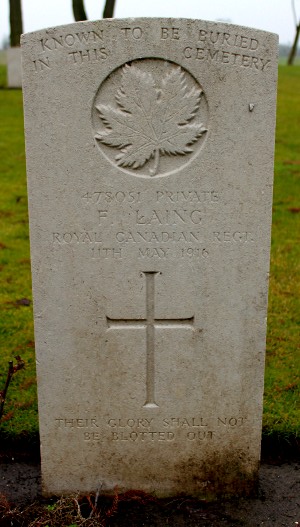
Commonwealth War Graves Commission Gravestone of Pte Fred Laing, located in the Maple Copse Cemetery, Belgium. Photo by "Fred", a member of the Canadian Expeditionary Force Study Group, an online forum.
Frederick Laing was a Driver in the Regiment's Depot Company at Halifax when he surrendered as a stowaway aboard the S.S. Caledonian on 27 Aug 1915. The ship had been at sea for less that a full day, but long enough to be sure it wouldn't be putting anyone ashore before continuing to England.
After surrendering himself, Laing was taken on the strength of the Battalion, and initially attached to "Base" Company for rations and discipline. He was transferred on to "A" Company on 13 Sep 1915 but returned to 'Base' Company ten days later.
Laing's regimental number 20265 was replaced by a new CEF service number, 478051, from the number block allocated to the Regiment. Laing did not, however, enter France with The RCR in November 1915 and rejoined Regiment on being transferred from the 11th Reserve Battalion on 26 March 1916.
His service in the field was brief, six weeks after joining the Regiment France, Frederick Laing would be reported Killed in Action. The War Diary for 11 May 1916 reads:
11.5.16. - Trenches
Situation quiet. Wind S.W. to W.
No. 478051 Pte. LAING, F. Killed in Action by enemy shell at BORDER DUGOUTS. Buried I.24.c.3.9. Sheet 28 (MAPLE COPSE.)
478051 Pte Frederick Freeman Laing is buried in Maple Copse Cemetery, Belgium.
478046 Sergeant Auquatine McNulty
With one year and nine months of prior service, Auquatine McNulty held the rank of Driver in the Canadian Permanent Army Service Corps (C.P.A.S.C.) in 1915 when he surrendered himself as a stowaway aboard the Caledonian on 27 Aug 1915. Having chosen to stow away on the Regiment's troopship, he was offered the opportunity to join the CEF as an infantry soldier. He signed his Attestation Papers on 20 Sep 1915 and was posted to 'A' Company with the regimental number 16412, which was shortly thereafter replaced by the new CEF service number 478046.
McNulty's service history encompasses a wide variety for experiences that we associate with soldiers of the First World War. He spent time in England (on leave and while recovering after being wounded), he was married, promoted (to Corporal and then to Sergeant), charged (twice for absences without proper authority), and decorated for bravery in battle. After each departure from the battlefield, he returned to serve with the Regiment. McNulty was not finally struck off the strength of The RCR until February 1919 when he was released in England on demobilization.
The award of Sergeant McNulty's Military Medal was published in the London Gazette issue of 3 July 1919. Citations for late-war awards of the Military Medal were not published and cannot be found in the remaining files at the Library and Archives Canada, but the first volume of the regimental history does offer an indication of McNulty's actions during operations at Canal du Nord (27 Sep - 1 Oct 1918):
'Sergt. A. McNulty, who personally cleared a machine-gun post that was holding up his company's attack' - (Fetherstonhaugh, pp. 365)
478047 Private Joseph Molloy
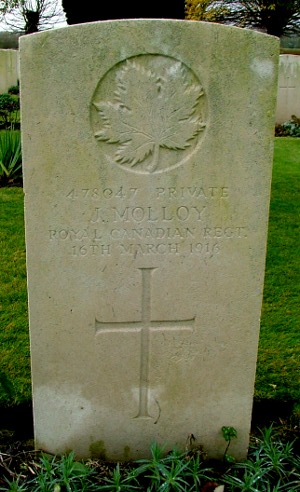
Commonwealth War Graves Commission Gravestone of Pte Joseph Molloy, located in the Meteren Military Cemetery, Nord, France. Photo by "Fred", a member of the Canadian Expeditionary Force Study Group, an online forum.
Joseph Molloy, like Auquitaine McNulty, was a Driver in the C.P.A.S.C. when he stowed away aboard the Caledonian. Like his fellow stowaways, he was first attached to 'Base' Company for rations as discipline after he surrendered himself to the regimental authorities aboard the troopship. He had previously attested for overseas service with the 40th Battalion in the spring of 1915, but for some reason had remained in Halifax and perhaps felt that this was his best chance of getting to the front before the war ended (according to rumours of a short war). Since he was now on his way to England, and the only available unit on board was The RCR, Molloy signed his attestation papers on 26 Sep, with an effective enrolment date of 26 Aug 1915. He was given the regimental number 16413, which was later changed to the CEF service number 478047.
Posted to "A" Company while the Regiment prepared for service in France, Molloy would land in France on the 1st of November 1915 with The RCR but would have a short and poignant career with the Regiment. Twice in October 1915, before the Regiment crossed the Channel, Joseph Molloy would be paraded for summary trials. In the first he received a fine of five days pay for an absence of the same duration, and the second charge resulted in 120 hours of detention for drunkenness.
Once in France, Molloy's behaviour did not improve. In January 1916 he received a punishment of 14 days Field Punishment No. 2 for attempting to strike an NCO, insolence, and drunkenness. This was followed by a Court Martial on 11 Mar 1916, once again charge with drunkenness, for which Molloy was awarded a punishment of 56 days Field Punishment No. 1.
Sadly, the pressures of front line service appear to have been too much for Joseph Molloy to bear, the Regiment's War Diary provides a sparse summary of the end of his Regimental service:
16-3-16 - Monte des Cats
No. 478047 Pte MOLLOY, J. "C" Coy. Killed (Self inflicted Wound).
17-3-16 - Monte des Cats
The late No. 478047 Pte MOLLOY, J. Buried at R.22.a.5.
478047 Private Joseph Molloy now rests in the Meteren Military Cemetery; Nord, France.
478050 Private Leo Landry
Leo Landry had been serving in the Canadian Permanent Army Service Corps (C.P.A.S.C.) for six months and held the rank of Driver when he decided to stow away on the S.S. Caledonian. He surrendered himself on 27 Aug 1915 and was attached to the "Base" Company for rations and disciplinary purposes.
Attached on "A" Company on 13 Sep 1915, Landry formally attested for overseas service at Shorncliffe on 15 Sep 1915. He was assigned the regimental number 16414, which was later changed to the CEF service number 478050.
Leo Landry served with the Regiment until he was Killed in Action on 4 Jun 1916. Having no known grave, he is commemorated on the Menin Gate Memorial at Ypres, Belgium.
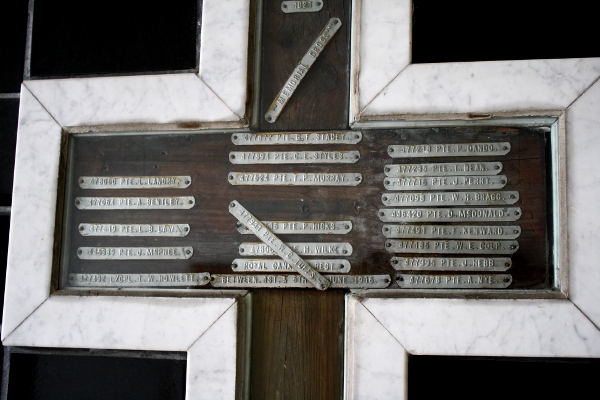
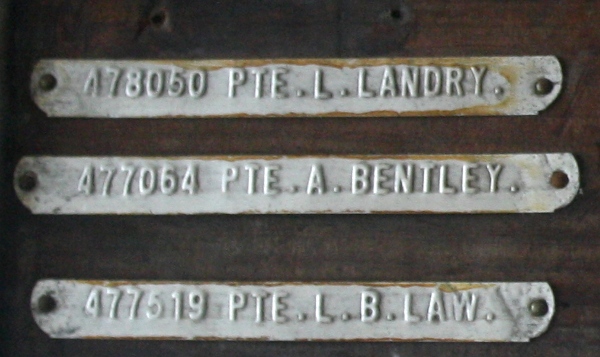
Pte Leo Landry's name can be found on the battlefield memorial cross which is part of the collection in The Royal Canadian Regiment Museum. This cross has for many years been placed in the wall of the Memorial Arch in Wolseley Hall, but is currently in secure storage during the renovations of the Museum. Photo by Capt Michael O'Leary.
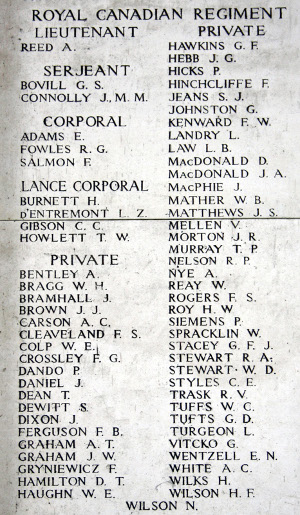
Pte Leo Landry is included among the names of Royal Canadians who fell in the Ypres Salient and have no known grave and inscribed on the Menin Gate (Ypres) Memorial. Photo by Judy Rieck, a member of the Great War Forum.
478049 Private Ernest Naylor (a.k.a. Ernest Carroll)
Ernest Naylor, on attestation to serve overseas with The RCR, admitted to having served previously with the Regiment. He also initially identified himself as "Gunner Ernest Carroll" of the 1st Canadian Garrison Artillery. Naylor, having identified himself as a stowaway on the S.S. Caledonian on 28 Aug 1915, signed his attestation form on 15 Sep 1915, the documents beings backdated to be effective from the day the S.S. Caledonian sailed from Halifax, 26 Aug 1915. When he signed the attestation papers, Naylor also admitted to his proper identity and his true name was recorded by the Regiment. Having been serving under the Artillery's regimental number 210, on attestation Naylor was assigned the regimental number 16415, and this was later changed to the CEF service number 478049.
Ernest Naylor continued to serve with the Regiment until 9 Sep 1916, when his medical fitness to serve was classified as "Permanent Base" and he was transferred to the Canadian Corps Assembly centre (CCAC) at Folkestone.
478052 Private Thomas O'Meara
Private Thomas O'Meara was a soldier of the Manchester Draft of 1907, which provided over 150 new soldiers to the Regiment shortly after its occupation of the Halifax garrison. He served with The RCR in Halifax until 31 Dec 1912, when he was discharged for misconduct. His character was recorded as 'bad' at the time of his discharge.
O'Meara, however, did not give up soldiering and was serving in the Militia, with the 66th Regiment, Princess Louise Fusiliers, in 1915. On 28 Aug 1915 he returned to duty with The RCR when he surrendered himself aboard the S.S. Caledonian en route to England. Like the other stowaways, he was first attached to the 'Base' Company for rations and discipline. On 22 Sep 1915, O'Meara signed his Attestation Papers volunteering for overseas service, effective 26 Aug 1915. He was initially allotted the regimental number 16416, but this later changed to the CEF service number 478052.
While the Regiment was at Shornecliffe awaiting orders for France, O'Meara was medically examined for re-enrolment in the Permanent Force. At 33 years of age, he was described as 5'6" tall, 142 lbs, with a 37" chest and a physical development noted simply as "Perfect."
Thomas O'Meara landed in France with the Regiment on 1 Nov 1915. After a year at the front he was given a rest when he was tasked to work at the Brigade Washing and Drying Plant from Dec 1916 until Feb 1917. He had another short task with the Divisional Headquarters in May that year, and was hospitalized in July 1917 with diagnoses of delirium tremens and alcoholism. His medical problems continued when he was hospitalized in August 1917, the Daily Orders noting a 'stoppage of pay at the rate of 50 cents per diem whilst in hospital' for Venereal Disease.
Following his release from hospital, O'Meara was transferred to the 3rd Canadian Infantry Base Depot and given a medical classification of "Permanent Base." He was thereafter transferred to the Canadian Labour Pool and struck off the strength of the Regiment on 16 Oct 1917 to become a Cook in the Canadian Forestry Corps.
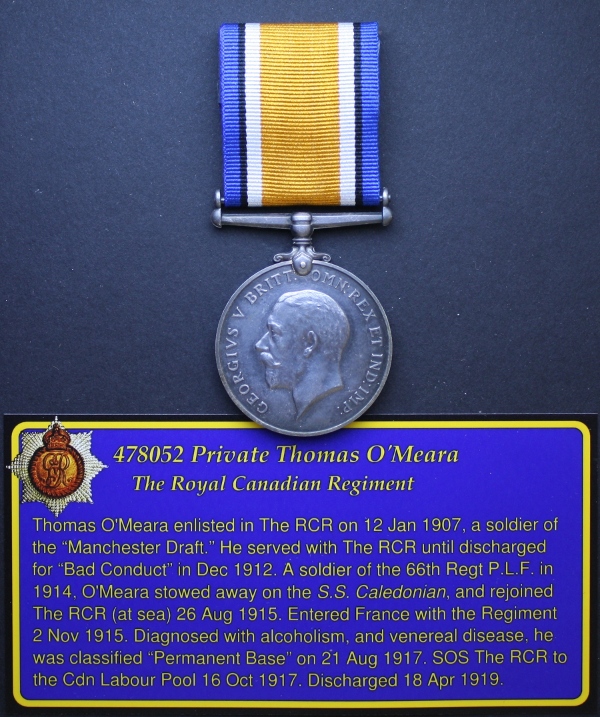
The British War medal awarded to Pte Thomas O'Meara. Photo by Capt Michael O'Leary. (Private collection.)
478048 Private Alfred Shaw
Alfred Shaw had been a soldier of the 66th Regiment, Princess Louise Fusiliers, when he stowed away aboard the S.S. Caledonian, surrendering himself on 28 Aug 1915. He was taken on the strength of The RCR as an attachment for for rations and discipline, joining "A" Company. Shaw's Attestation Paper identifies six years prior service with The RCR, which possibly provided his impetus to join his old unit and his old comrades on their voyage to England and the war.
It was not until 20 Sep 1915 that Shaw was attested for overseas service with The RCR, and his attestation was back-dated to take effect from the Regiment's date of sailing 26 Aug 1915. He was assigned the regimental number 16411, which was later changed to the CEF service number 478048.
Alfred Shaw continued to serve with The RCR in France until he was evacuated wounded on 10 Aug 1918. He crossed to England on the Hospital Ship Guildford and was struck off the strength of the Regiment to the Nova Scotia Regimental Depot in Bramshott. While the date of Shaw's return to the Regiment is not recorded in the unit's Daily Orders, he was finally struck off strength of the unit to the Canadian Record List on 6 Feb 1919 for his return to Canada.
Conclusion
Seven men — one Royal Canadian, one Gunner, two Militiamen (both of whom were pre-War RCR soldiers), and three soldiers of the Permanent Army Service Corps — perhaps each felt that they would miss their chance if they didn't take action to get overseas at their first opportunity. The action each chose, singly or perhaps in small groups, and quite possibly with some being aided by friends in the Regiment, was to stow away aboard the troopship S.S. Caledonian.
They were a varied assortment of soldiers, and their individual stories resulted in a broad range of experiences and final dispositions. Three remain on France soil; two Killed in Action and one by suicide, with one of the former having no known grave. Two were medically reclassified to 'Permanent Base' employment and left the Regiment when they could no longer serve in the front line trenches. The remaining two served with The RCR throughout the war, one being decorated for bravery for his actions in the war's final months.
Despite their varied backgrounds and experiences, each has contributed to the story of our Regiment in the First World War. Their stories are also our own.
Pro Patria
- The O'Leary Collection; Medals of The Royal Canadian Regiment.
- Researching Canadian Soldiers of the First World War
- Researching The Royal Canadian Regiment
- The RCR in the First World War
- Badges of The RCR
- The Senior Subaltern
- The Minute Book
- Rogue Papers
- Tactical Primers
- The Regimental Library
- Battle Honours
- Perpetuation of the CEF
- A Miscellany
- Quotes
- The Frontenac Times
- Site Map

![]() The RCR in the Great War
The RCR in the Great War
![]() War Diary
War Diary
![]() Battle Honours
Battle Honours
![]() Battle Bars and The RCR
Battle Bars and The RCR
![]() The RCR Battle Bar Ledger (pdf)
The RCR Battle Bar Ledger (pdf)
![]() Honours and Awards
Honours and Awards
![]() Roll of Honour
Roll of Honour
![]() Prisoners of War
Prisoners of War
![]() Cemetery List
Cemetery List
![]() Cemetery Map
Cemetery Map
![]() Courts Martial
Courts Martial
![]() Officers
Officers
![]() RSMs of The RCR (1914-1919)
RSMs of The RCR (1914-1919)
![]() NCOs and Soldiers
NCOs and Soldiers
![]() An Officer's Diary (1914-1918)
An Officer's Diary (1914-1918)
![]() Recollections of a Nonagenerian (R. England) (1916-1919)
Recollections of a Nonagenerian (R. England) (1916-1919)
![]() On to Bermuda (1914-15)
On to Bermuda (1914-15)
![]() England and France 1915-1916 (Hayes; 1931)
England and France 1915-1916 (Hayes; 1931)
![]() Overseas with The Royals (1915)
Overseas with The Royals (1915)
![]() Regimental History Pamphlet (1917)
Regimental History Pamphlet (1917)
![]() Amiens (1918)
Amiens (1918)
![]() Cambrai (1918)
Cambrai (1918)
![]() Monchy-le-Preux (1918)
Monchy-le-Preux (1918)
![]() Under-aged Soldiers in The RCR
Under-aged Soldiers in The RCR
![]() Not All Were Volunteers; The RCR and the Military Service Act
Not All Were Volunteers; The RCR and the Military Service Act
![]() Sentenced to Death by Court Martial
Sentenced to Death by Court Martial
![]() The 7th Trench Mortar Battery
The 7th Trench Mortar Battery
![]() A Regimental Goat
A Regimental Goat
![]() Regiment and Family, Bermuda 1914-15
Regiment and Family, Bermuda 1914-15
![]() "March the Guilty Bastard In"
"March the Guilty Bastard In"
![]() Surrendered as Stowaway
Surrendered as Stowaway
![]() Re-Visiting the Great War Roll of Honour for The RCR
Re-Visiting the Great War Roll of Honour for The RCR
![]() Canadian Corps Trench Standing Orders (1916)
Canadian Corps Trench Standing Orders (1916)
